AI图像与故事生成:FastAPI、Groq与Replicate的应用指南
介绍
AI 图像生成器和故事创建器是一款 Web 应用程序,它利用先进的 AI 技术为用户提供一个交互式平台,用于根据音频提示生成图像和故事。该应用程序使用 FastAPI 作为后端,从而能够高效处理请求和响应,而前端则使用 HTML、CSS(DaisyUI 和 Tailwind CSS)和 JavaScript 构建,以实现响应式用户体验。该应用程序分别利用 llama-3.1–70b 生成提示、black-forest-labs/flux-1.1-pro 生成图像以及 llava-v1.5–7b vbision 模型通过 Groq 和 Replicat.AI 创作故事。
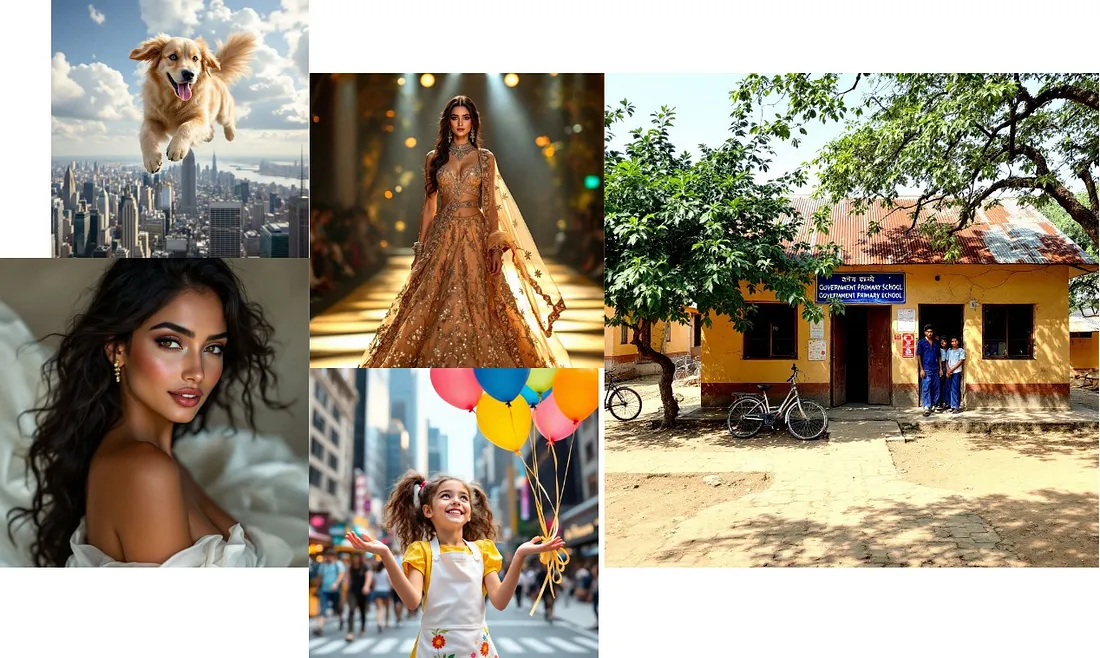
主要特点:
1. 录音和转录:用户可以录制他们的语音提示,然后使用语音识别技术将其转录成文本。
2. 图像生成:根据转录的文本,应用程序生成详细的图像提示,并使用 Replicate API 创建相应的图像。

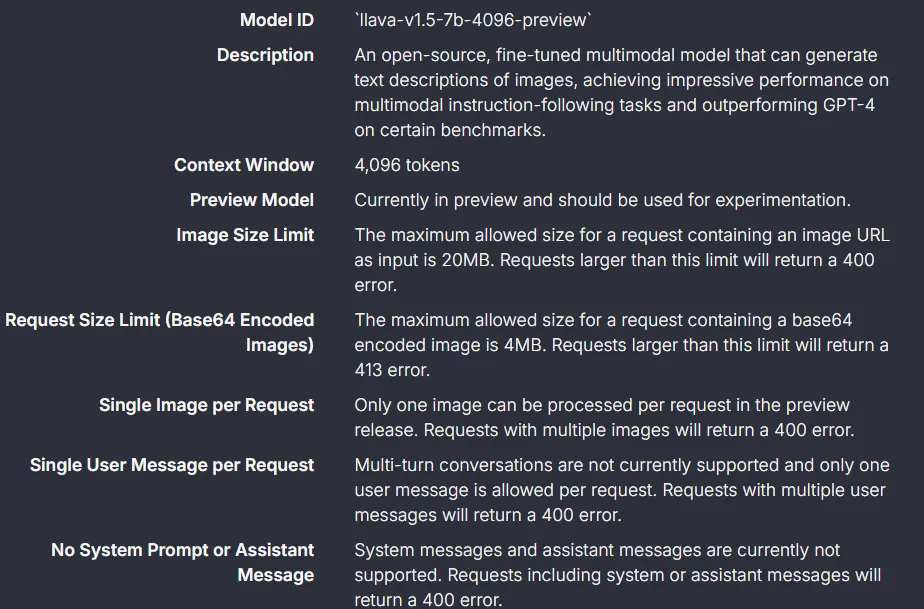
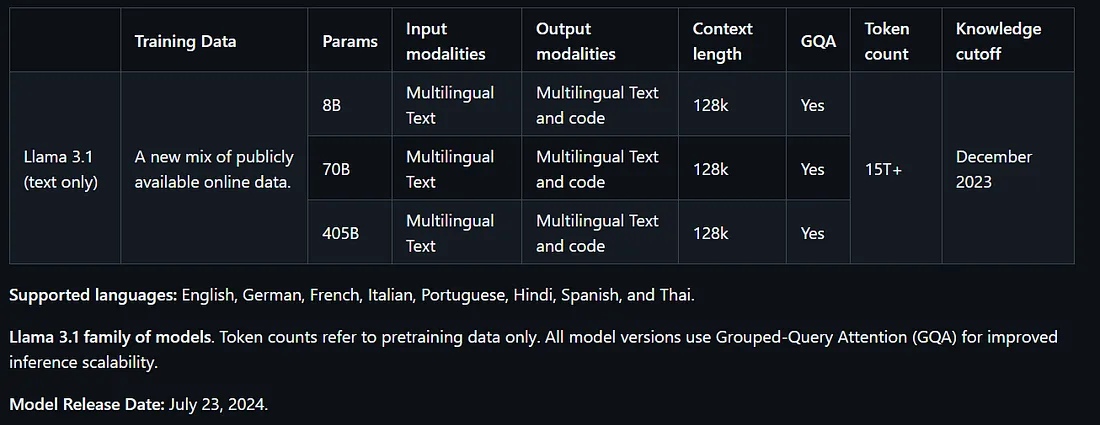
3. 图片下载:用户可以将生成的图片下载到本地设备。
4. 故事生成:该应用程序可以根据创建的图像生成引人入胜的故事,为视觉内容提供叙述背景。
5. 用户友好界面:该应用程序具有简洁直观的界面,方便用户与各种功能进行交互。
使用的技术:
- 后端:FastAPI、Groq、Replicate.ai、SpeechRecognition
- 前端:HTML、CSS(DaisyUI、Tailwind CSS)、JavaScript
- 图像处理:Pillow 用于图像处理
- 异步操作:aiohttp 和 aiofiles 用于高效的文件处理和网络请求
该项目展示了如何将多种人工智能服务集成到一个统一的应用程序中,让用户可以探索人工智能生成内容的创造性可能性
需要安装的软件包:
fastapi
uvicorn
jinja2
python-multipart
pydantic
python-dotenv
groq
replicate
SpeechRecognition
pydub
aiohttp
aiofiles
Pillow
你可以使用 pip 安装这些软件包:
pip install fastapi uvicorn jinja2 python-multipart pydantic python-dotenv groq replicate SpeechRecognition pydub aiohttp aiofiles Pillow
执行说明:
设置环境变量: 在根目录下创建一个 .env 文件,内容如下:
GROQ_API_KEY=your_groq_api_key_here
REPLICATE_API_TOKEN=your_replicate_api_token_here
用实际的 API 密钥替换占位符值。
确保所有必要文件都已就位:
- app/main.py
- app/config.py
- app/utils.py
- 模板/index.html
- static/css/styles.css
- static/js/script.js
运行 FastAPI 服务器: 导航至包含 app/main.py 的目录并运行:
uvicorn app.main:app - reload
访问应用程序:
- 打开网络浏览器,进入http://127.0.0.1:8000
使用应用程序:
- a. 单击 “开始录音”,然后按提示说话。
- b. 完成后点击 “停止录音”。
- c. 音频将自动转录。
- d. 单击 “生成图像提示”,创建详细提示。
- e. 单击 “生成图像”,根据提示创建图像。
- f. 使用 “下载图像 ”按钮保存生成的图像。
- g. 单击 “生成故事”,根据生成的图像创建故事。
该应用程序展示了各种人工智能技术的复杂集成,包括语音识别、语言模型和图像生成,所有这些都封装在一个用户友好的 Web 界面中。
FastAPI 用户界面如下图所示
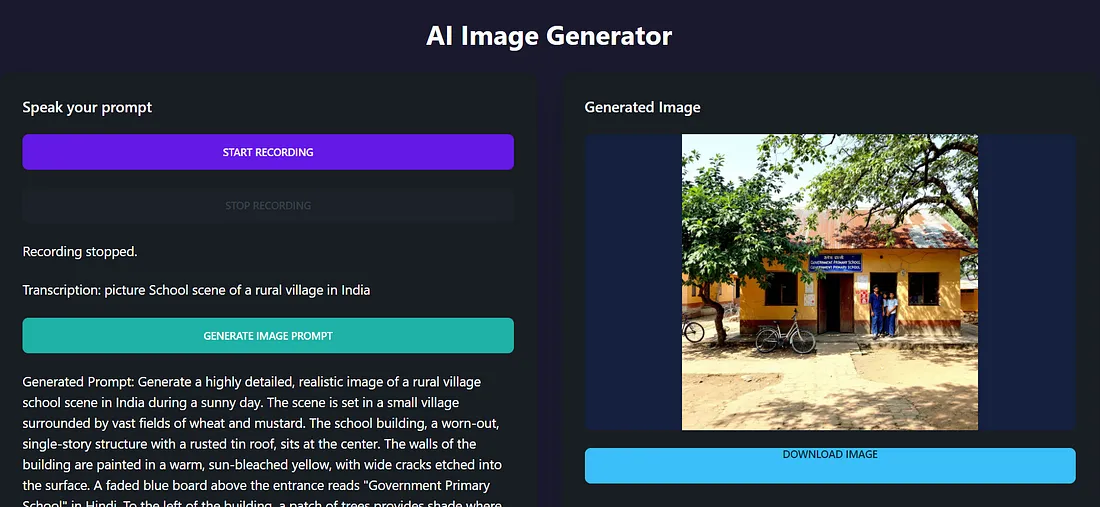

人工智能图像生成器应用程序
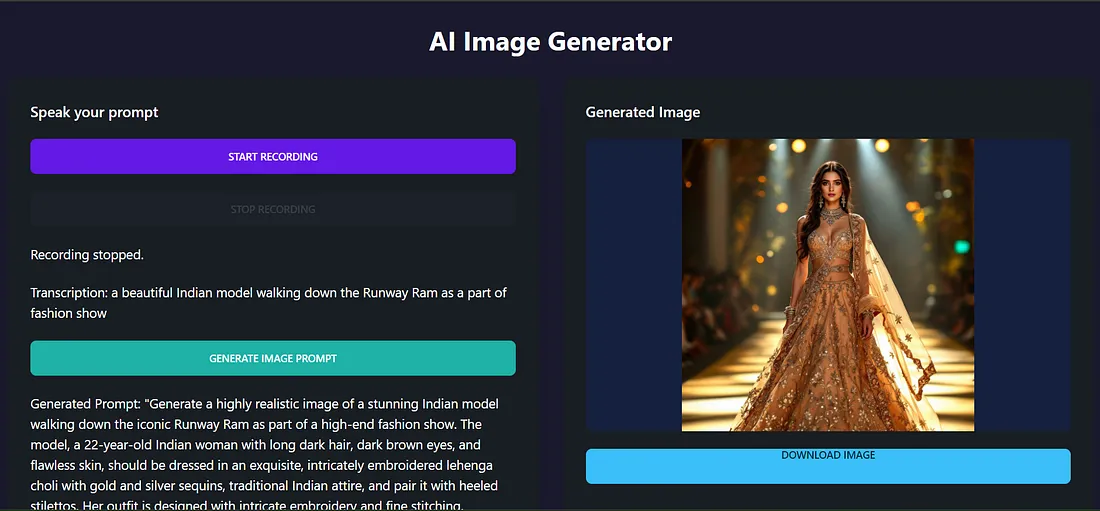
说出你的提示
- 开始录音
- 停止录音
- 转录(转录文本):作为时装秀的一部分,一位美丽的印度模特走在 Runway Ram 上。
- 根据转录文本创建新提示,生成图像
- - 生成的提示 "生成一个高度逼真的图像,显示一名漂亮的印度模特走在标志性的 Runway Ram 上,这是一场高端时装秀的一部分 该模特是一名 22 岁的印度女性,深色长发,深棕色眼睛,皮肤完美无瑕,应身着精致的、绣有金银亮片的 lehenga choli,这是印度的传统服装,并搭配有跟高跟鞋。她的服装采用复杂的刺绣和精细的缝线设计 强调优雅的褶皱、闪亮的面料,以及她优雅的姿态和自信的步伐 在她的手部、颈部和单侧发型上融入精致的首饰,如珠子、金镯子和项链。灯光效果起着重要作用,设置暖色调的舞台大灯,突出模特的服装,并用淡淡的蓝色调照亮整个环境。拍摄角度应充分展示服装的细节。所需的场景视角是正面拍摄模特的全身,模特位于中间,周围的 T 台用强烈的金色灯光从内部照亮。
生成图像

代码执行
创建虚拟环境
要使用 Python 的 venv 模块创建虚拟环境,请按照以下步骤操作:
- 打开终端或命令提示符。
- 导航到项目目录(在此创建虚拟环境)。你可以使用 cd 命令更改目录。 例如:
cd path/to/your/project
- 运行以下命令创建虚拟环境:
python -m venv venv
- 该命令将在项目文件夹中创建一个名为 venv 的新目录,其中将包含虚拟环境(在 Windows 环境下)
- 激活虚拟环境:
venv\Scripts\activate
文件夹结构
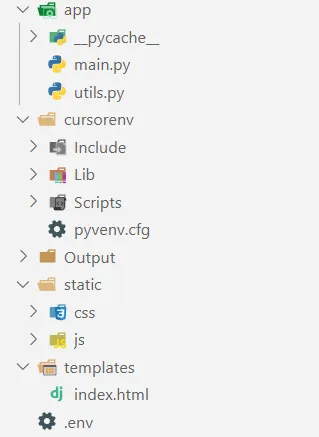
- utils.py
import base64
import os
from pydub import AudioSegment
def save_audio(audio_data):
# Decode the base64 audio data
audio_bytes = base64.b64decode(audio_data.split(",")[1])
# Save the audio to a temporary file
temp_file = "temp_audio.webm"
with open(temp_file, "wb") as f:
f.write(audio_bytes)
# Convert WebM to WAV
audio = AudioSegment.from_file(temp_file, format="webm")
wav_file = "temp_audio.wav"
audio.export(wav_file, format="wav")
# Remove the temporary WebM file
os.remove(temp_file)
return wav_file
def text_to_speech(text):
# Implement text-to-speech functionality if needed
pass
- main.py
"""
1. Record audio through their microphone
2. Transcribe the audio to text
3. Generate an image prompt using the Groq Llama3 model
4. Generate an image using the Replicate.ai Flux model
5. Display the generated image
6. Download the generated image
The application uses DaisyUI and Tailwind CSS for styling, providing a dark mode interface. The layout is responsive and should work well on both desktop and mobile devices.
Note: You may need to adjust some parts of the code depending on the specific APIs and models you're using, as well as any security considerations for your deployment environment.
"""
from fastapi import FastAPI, Request, HTTPException
from fastapi.templating import Jinja2Templates
from fastapi.staticfiles import StaticFiles
from fastapi.responses import JSONResponse, FileResponse
from pydantic import BaseModel
import speech_recognition as sr
from groq import Groq
import replicate
import os
import aiohttp
import aiofiles
import time
from dotenv import load_dotenv
load_dotenv()
from .utils import text_to_speech, save_audio
from PIL import Image
import io
import base64
import base64
# Function to encode the image
def encode_image(image_path):
with open(image_path, "rb") as image_file:
return base64.b64encode(image_file.read()).decode('utf-8')
app = FastAPI()
app.mount("/static", StaticFiles(directory="static"), name="static")
templates = Jinja2Templates(directory="templates")
# Initialize Groq client with the API key
GROQ_API_KEY = os.getenv("GROQ_API_KEY")
if not GROQ_API_KEY:
raise ValueError("GROQ_API_KEY is not set in the environment variables")
groq_client = Groq(api_key=GROQ_API_KEY)
class AudioData(BaseModel):
audio_data: str
class ImagePrompt(BaseModel):
prompt: str
class PromptRequest(BaseModel):
text: str
# Add this new model
class FreeImagePrompt(BaseModel):
prompt: str
image_path: str
@app.get("/")
async def read_root(request: Request):
return templates.TemplateResponse("index.html", {"request": request})
@app.post("/transcribe")
async def transcribe_audio(audio_data: AudioData):
try:
# Save the audio data to a file
audio_file = save_audio(audio_data.audio_data)
# Transcribe the audio
recognizer = sr.Recognizer()
with sr.AudioFile(audio_file) as source:
audio = recognizer.record(source)
text = recognizer.recognize_google(audio)
return JSONResponse(content={"text": text})
except Exception as e:
raise HTTPException(status_code=400, detail=str(e))
@app.post("/generate_prompt")
async def generate_prompt(prompt_request: PromptRequest):
try:
text = prompt_request.text
# Use Groq to generate a new prompt
response = groq_client.chat.completions.create(
messages=[
{"role": "system", "content": "You are a creative assistant that generates prompts for realistic image generation."},
{"role": "user", "content": f"Generate a detailed prompt for a realistic image based on this description: {text}.The prompt should be clear and detailed in no more than 200 words."}
],
model="llama-3.1-70b-versatile",
max_tokens=256
)
generated_prompt = response.choices[0].message.content
print(f"tweaked prompt:{generated_prompt}")
return JSONResponse(content={"prompt": generated_prompt})
except Exception as e:
print(f"Error generating prompt: {str(e)}")
raise HTTPException(status_code=400, detail=str(e))
@app.post("/generate_image")
async def generate_image(image_prompt: ImagePrompt):
try:
prompt = image_prompt.prompt
print(f"Received prompt: {prompt}")
# Use Replicate to generate an image
output = replicate.run(
"black-forest-labs/flux-1.1-pro",
input={
"prompt": prompt,
"aspect_ratio": "1:1",
"output_format": "jpg",
"output_quality": 80,
"safety_tolerance": 2,
"prompt_upsampling": True
}
)
print(f"Raw output: {output}")
print(f"Output type: {type(output)}")
# Convert the FileOutput object to a string
image_url = str(output)
print(f"Generated image URL: {image_url}")
return JSONResponse(content={"image_url": image_url})
except Exception as e:
print(f"Error generating image: {str(e)}")
raise HTTPException(status_code=400, detail=str(e))
@app.get("/download_image")
async def download_image(image_url: str):
try:
# Create Output folder if it doesn't exist
output_folder = "Output"
os.makedirs(output_folder, exist_ok=True)
# Generate a unique filename
filename = f"generated_image_{int(time.time())}.jpg"
filepath = os.path.join(output_folder, filename)
# Download the image
async with aiohttp.ClientSession() as session:
async with session.get(image_url) as resp:
if resp.status == 200:
async with aiofiles.open(filepath, mode='wb') as f:
await f.write(await resp.read())
# Return the filepath and filename
return JSONResponse(content={
"filepath": filepath,
"filename": filename
})
except Exception as e:
print(f"Error downloading image: {str(e)}")
raise HTTPException(status_code=400, detail=str(e))
class StoryRequest(BaseModel):
filepath: str
filename: str
@app.post("/generate_story_from_image")
async def generate_story_from_image(content: StoryRequest):
try:
image_path = content.filepath
print(f"Image path: {image_path}")
# Check if the file exists
if not os.path.exists(image_path):
raise HTTPException(status_code=400, detail="Image file not found")
# Getting the base64 string
base64_image = encode_image(image_path)
client = Groq()
chat_completion = client.chat.completions.create(
messages=[
{
"role": "user",
"content": [
{"type": "text", "text": "Generate a clear,concise,meaningful and engaging cover story for a highly acclaimed leisure magazine based on the image provided. The story should keep the audience glued and engaged and the story should bewithin 200 words."},
{
"type": "image_url",
"image_url": {
"url": f_"data:image/jpeg;base64,{base64_image}",
},
},
],
}
],
model="llava-v1.5-7b-4096-preview",
)
story = chat_completion.choices[0].message.content
print(f"Generated story: {story}")
return JSONResponse(content={"story": story})
except Exception as e:
print(f"Error generating story from the image: {str(e)}")
raise HTTPException(status_code=400, detail=str(e))
@app.get("/download/{filename}")
async def serve_file(filename: str):
file_path = os.path.join("Output", filename)
return FileResponse(file_path, filename=filename)
if __name__ == "__main__":
import uvicorn
uvicorn.run(app, host="0.0.0.0", port=8000)
- script.js
let mediaRecorder;
let audioChunks = [];
const startRecordingButton = document.getElementById('startRecording');
const stopRecordingButton = document.getElementById('stopRecording');
const recordingStatus = document.getElementById('recordingStatus');
const transcription = document.getElementById('transcription');
const generatePromptButton = document.getElementById('generatePrompt');
const generatedPrompt = document.getElementById('generatedPrompt');
const generateImageButton = document.getElementById('generateImage');
const generatedImage = document.getElementById('generatedImage');
const downloadLink = document.getElementById('downloadLink');
const generateStoryButton = document.getElementById('generateStory');
const generatedStory = document.getElementById('generatedStory');
startRecordingButton.addEventListener('click', startRecording);
stopRecordingButton.addEventListener('click', stopRecording);
generatePromptButton.addEventListener('click', generatePrompt);
generateImageButton.addEventListener('click', generateImage);
generateStoryButton.addEventListener('click', generateStory);
async function startRecording() {
const stream = await navigator.mediaDevices.getUserMedia({ audio: true });
mediaRecorder = new MediaRecorder(stream);
mediaRecorder.ondataavailable = (event) => {
audioChunks.push(event.data);
};
mediaRecorder.onstop = sendAudioToServer;
mediaRecorder.start();
startRecordingButton.disabled = true;
stopRecordingButton.disabled = false;
recordingStatus.textContent = 'Recording...';
}
function stopRecording() {
mediaRecorder.stop();
startRecordingButton.disabled = false;
stopRecordingButton.disabled = true;
recordingStatus.textContent = 'Recording stopped.';
}
async function sendAudioToServer() {
const audioBlob = new Blob(audioChunks, { type: 'audio/webm' });
const reader = new FileReader();
reader.readAsDataURL(audioBlob);
reader.onloadend = async () => {
const base64Audio = reader.result;
const response = await fetch('/transcribe', {
method: 'POST',
headers: {
'Content-Type': 'application/json',
},
body: JSON.stringify({ audio_data: base64Audio }),
});
const data = await response.json();
transcription.textContent = `Transcription: ${data.text}`;
generatePromptButton.disabled = false;
};
audioChunks = [];
}
async function generatePrompt() {
const text = transcription.textContent.replace('Transcription: ', '');
const response = await fetch('/generate_prompt', {
method: 'POST',
headers: {
'Content-Type': 'application/json',
},
body: JSON.stringify({ text: text }),
});
const data = await response.json();
generatedPrompt.textContent = `Generated Prompt: ${data.prompt}`;
generateImageButton.disabled = false;
}
async function generateImage() {
const prompt = generatedPrompt.textContent.replace('Generated Prompt: ', '');
const response = await fetch('/generate_image', {
method: 'POST',
headers: {
'Content-Type': 'application/json',
},
body: JSON.stringify({ prompt: prompt }),
});
const data = await response.json();
generatedImage.src = data.image_url;
// Download the image and get the filepath
const downloadResponse = await fetch(`/download_image?image_url=${encodeURIComponent(data.image_url)}`);
const downloadData = await downloadResponse.json();
// Store the filepath and filename for later use
generatedImage.dataset.filepath = downloadData.filepath;
generatedImage.dataset.filename = downloadData.filename;
// Set up the download link
downloadLink.href = `/download/${downloadData.filename}`;
downloadLink.download = downloadData.filename;
downloadLink.style.display = 'inline-block';
}
async function generateStory() {
const imagePath = generatedImage.dataset.filepath;
const filename = generatedImage.dataset.filename;
if (!imagePath || !filename) {
generatedStory.textContent = "Error: Please generate an image first.";
return;
}
try {
const response = await fetch('/generate_story_from_image', {
method: 'POST',
headers: {
'Content-Type': 'application/json',
},
body: JSON.stringify({ filepath: imagePath, filename: filename }),
});
if (!response.ok) {
throw new Error(`HTTP error! status: ${response.status}`);
}
const data = await response.json();
// Display the generated story
generatedStory.textContent = data.story;
// Make sure the story container is visible
document.getElementById('storyContainer').style.display = 'block';
} catch (error) {
console.error('Error:', error);
generatedStory.textContent = `Error: ${error.message}`;
}
}
// Modify the download link click event
downloadLink.addEventListener('click', async (event) => {
event.preventDefault();
const response = await fetch(downloadLink.href);
const blob = await response.blob();
const url = window.URL.createObjectURL(blob);
const a = document.createElement('a');
a.style.display = 'none';
a.href = url;
a.download = response.headers.get('Content-Disposition').split('filename=')[1];
document.body.appendChild(a);
a.click();
window.URL.revokeObjectURL(url);
});
- style.css
body {
background-color: #1a1a2e;
color: #ffffff;
}
.container {
max-width: 1200px;
}
#imageContainer {
min-height: 300px;
display: flex;
align-items: center;
justify-content: center;
background-color: #16213e;
border-radius: 8px;
}
#generatedImage {
max-width: 100%;
max-height: 400px;
object-fit: contain;
}- index.html
<!DOCTYPE html>
<html lang="en" data-theme="dark">
<head>
<meta charset="UTF-8">
<meta name="viewport" content="width=device-width, initial-scale=1.0">
<title>AI Image Generator</title>
<link href="https://cdn.jsdelivr.net/npm/daisyui@3.7.3/dist/full.css" rel="stylesheet" type="text/css" />
<script src="https://cdn.tailwindcss.com"></script>
<link rel="stylesheet" href="{{ url_for('static', path='/css/styles.css') }}">
</head>
<body>
<div class="container mx-auto px-4 py-8">
<h1 class="text-4xl font-bold mb-8 text-center">AI Image Generator</h1>
<div class="grid grid-cols-1 md:grid-cols-2 gap-8">
<div class="card bg-base-200 shadow-xl">
<div class="card-body">
<h2 class="card-title mb-4">Speak your prompt</h2>
<button id="startRecording" class="btn btn-primary mb-4">Start Recording</button>
<button id="stopRecording" class="btn btn-secondary mb-4" disabled>Stop Recording</button>
<div id="recordingStatus" class="text-lg mb-4"></div>
<div id="transcription" class="text-lg mb-4"></div>
<button id="generatePrompt" class="btn btn-accent mb-4" disabled>Generate Image Prompt</button>
<div id="generatedPrompt" class="text-lg mb-4"></div>
<button id="generateImage" class="btn btn-success" disabled>Generate Image</button>
</div>
</div>
<div class="card bg-base-200 shadow-xl">
<div class="card-body">
<h2 class="card-title mb-4">Generated Image</h2>
<div id="imageContainer" class="mb-4">
<img id="generatedImage" src="" alt="Generated Image" class="w-full h-auto">
</div>
<a id="downloadLink" href="#" download="generated_image.png" class="btn btn-info" style="display: none;">Download Image</a>
</div>
</div>
</div>
<!-- Add this new section after the existing cards -->
<div class="card bg-base-200 shadow-xl mt-8">
<div class="card-body">
<h2 class="card-title mb-4">Generate Story from Image</h2>
<button id="generateStory" class="btn btn-primary mb-4">Generate Story</button>
<div id="storyContainer" class="mb-4">
<p id="generatedStory" class="text-lg"></p>
</div>
</div>
</div>
</div>
<script src="{{ url_for('static', path='/js/script.js') }}"></script>
</body>
</html>































